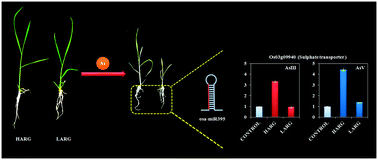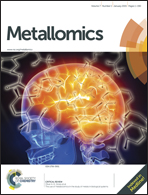Differential expression of microRNAs by arsenate and arsenite stress in natural accessions of rice†
Abstract
Arsenic (As) contamination of rice (Oryza sativa) imposes a serious threat to human health worldwide. Understanding the molecular mechanisms of As transport and accumulation in rice may provide promising solutions to the problem. MicroRNAs (miRNAs) are a novel class of short, endogenous, non-coding small RNA molecules involved in a wide variety of biological processes such as organ polarity, morphogenesis, floral transition, hormone signalling and adaptation to environment. In the past, a few studies led to the identification of differentially expressed miRNAs in rice in response to arsenite (As(III)) stress. However, studies related to differential miRNA expression involving natural rice accessions exposed to different species of As have not been carried out. Such studies are required to identify As-species responsive miRNAs in different rice accessions. In this study, we have carried out miRNA profiling in contrasting As accumulating rice accessions using miRNA Array. We report identification of differentially expressed miRNAs in contrasting As accumulating rice cultivars in response to As(III) (25 μM) and As(V) (50 μM) stress. A significant up-regulation in expression was observed among members of the miR396, miR399, miR408, miR528, miR1861, miR2102 and miR2907 families in response to As(III) and As(V) stress in both cultivars. In addition, members of the miR164, miR171, miR395, miR529, miR820, miR1432 and miR1846 families were down-regulated. The differentially expressed miRNAs were subjected to validation of expression and bioinformatic analyses to predict and categorise the key miRNAs and their target genes involved in As stress. Analysis suggests that As-species and rice accession specific miRNA might be responsible for the differential response of contrasting rice accessions towards As(III) and As(V) stress. Study of the proximal promoter sequences of the As-responsive miRNAs suggests that these identified miRNAs contain metal-responsive cis-acting motifs and other elicitor and hormonal related motifs. Our study suggests a miRNA-dependent regulatory mechanism during As species-specific stress in different rice accessions. Further analysis based on results obtained will be helpful in dissecting the molecular mechanism behind As responses in different rice accessions.


 Please wait while we load your content...
Please wait while we load your content...